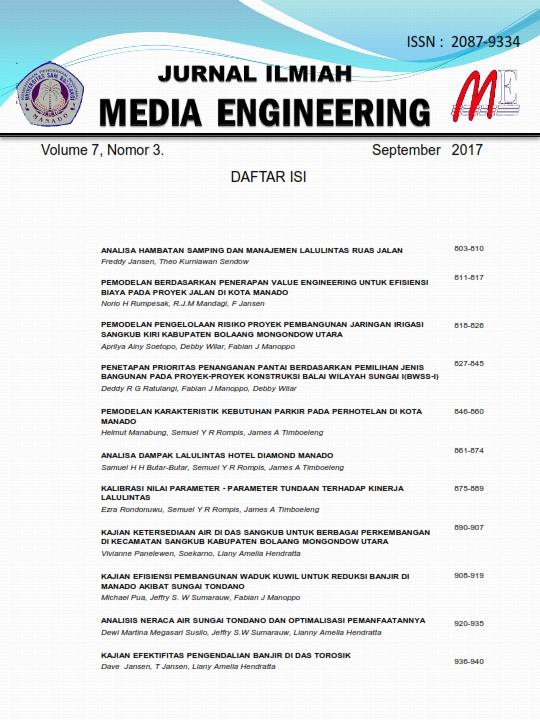Kalibrasi Nilai Parameter-Parameter Tundaan Terhadap Kinerja Lalulintas
Abstract
One of the methods used in the calculation of the travel time of a vehicle on one road segment is the volume-delay function. This delay function is an exponential relationship between the volume of vehicles traveling across a road to the capacity of this road. Travel time is an important element in the transportation system. How a driver or traveler chooses a travel route to reach their destination is determined by travel time. Volume Delay Function, VDF, is a major component in the equilibrium of a route selection model because it could influence drivers to change the route of travel by considering and comparing traffic volumes on each alternative path. Variables used in VDF were consist of travel time, travel time of free flow, traffic volume and roadway capacity of considered road segment; whereas for the existing parameters are the exponential functional coefficient namely the comparison between the traffic volume with the capacity of the road segment in which the traffic volume is calculated. These parameters imply the explanation of the condition of the road segment under considered.In macroscopic traffic engineering it could be seen that in order to study a traffic flow, there are three variables namely flow (volume, flow), speed (speed), and density (density). In practice, the relationship between speed and volume could be used for many purposes in planning, managing and determining transport policies, while microscopically, the flow of traffic is a configuration of a combination of movement of each vehicle separately, and also the configuration of the movement of the driver or traveler and his vehicle.
In this study the VDF were categories in two parts namely the mathematical and behavioral sections. This is done in order to clarify the process of calibrating the parameters and mathematical variables contained in VDF, in order to implement its objectives on the road segments of existing review in Manado city. As it is known that the policy of Manado city government to determine the direction of traffic flow towards the center of Manado city has been applied from several years ago. With the determination of the direction of traffic flow on the segment of the primary roads in the city of Manado, then the travel time to the center of Manado could be to review.
Based on this, it were try to apply the Volume-Delay Function on the road in Manado in accordance with the policy of traffic flow direction as imposed by the Local Government of Manado.
The aims of this research were to know the traffic flow that occur at peak hour in Pierre Tendean,s road segment; To know the amount of free travel time that occurred in Pierre Tendean,s road segment and to perform calibration due to the behavior of parameters on volume-delay function as is applied to road segment review in Manado city.
In this research, it were used observation method to collect primary and secondary data. The determination of unit of observation sample were based on Stratified Cluster Sampling Method.
Based on the results it could be revealed as follows: (1). The primary survey in the form of traffic survey on road with artery function in Manado City, were result in traffic data obtained during peak hour as below: The morning’s peak hour at  Boulevard road artery road segment were results in the maximum travel time (T) of 7.236 minutes with a vehicle capacity of 2752 smp / hour.(2). The afternoon’s peak hour at Boulevard artery road segment were result in maximum. (3). The free-flow travel time (To) based on the result of the survey of travel time (T) ( in minutes) and capacity Q (smp / hour) with calculations generated for morning’s travel time free peak hour = 4.6022 minutes (0.076703855 hours), for afternoon’s travel time free peak hour = 6.9851 Minutes (0.11641783 hours), and for combined travel time free flow peak hour ( morning and afternoon) = 3.8559 Minutes (0.064264484 hours).(4). The calibration of delayed VDF parameter functions to BPR i.e.α value of 0.047384, and β value of 2.283846.
By this research, it is hoped that the calibration process of the parameters of the behavior of the road segment, i.e. the exponential coefficients, can be applied.
Â
Keywords: calibration, delay parameter, free travel time, peak hour, stratified clustered sampling, road capacity
Downloads
Published
Issue
Section
License
Copyright (c) 2019 Ezra Rondonuwu, Semuel Y. R. Rompis, James A. Timboeleng

This work is licensed under a Creative Commons Attribution-ShareAlike 4.0 International License.
- I declare that this paper ... (title of paper) ... is original and has not been published previously nor under consideration to be published elsewhere and that any necessary permission to quote from another source has been obtained.
- With the publication, I transfer the copyright to The Jurnal Ilmiah Media Engineering (PTSU-OJS). This copyright transfer shall cover the exclusive right to reproduce and distribute the article, including reprint, photographic reproduction of similar nature and translation. It shall also include the right to adapt the article for use in conjunction with computer system and programs including reproduction or publication in machine-readable form and incorporation in retrieval systems.
Author (also on behalf of any co-authors):
Signed
____________________Â
Name :
Date :


